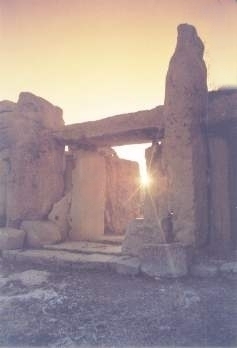

Among the various hypothesis to explain for the orientation
of Temples, the astronomical alignment of the Southern Temple at Mnajdra
can claim to embrace one of the most spectacular phenomena of all Maltese
Prehistory.
Interest by the local prehistoric folk in the heavens,
can be shown by a number of artefacts dating back to the Temple culture.
The most outstanding of these, is a slab of globigerina limestone found
at the temple of Tal-Qadi. Broken at a number of sides, it still preserves
the incised image of a crescent moon with that of a number of stars, within
segments formed by lines radiating from a ( now missing ) centre. This
is not the only artefact on which stars are represented - a decorated sherd
found at Hagar Qim, illustrates a figure that has on more than one occasion
been interpreted as a solar wheel. The group of five
holes to the eastern end of the Tarxien Temple facade, has been interpreted
by Zammit to be the representation of an as yet unknown constellation.
All this evidence coming from the temples themselves,
indicates that the people of the time had a fascination with the skies
to the point that they included a representing symbol of the skies in areas
of cult.This supports the view that specific celestial bodies could have
been used as a reference point on which Temples would be oriented.
The most spectacular suggestion of meaningful orientation of the megalithic remains, arises from the fact that the axis of southern temple at Mnajdra, dated to the early Tarxien phase, is pointing to the East. This means that the Temple's axis is aligned with the position of the sun at the equinox. Determination of the equinoxes is unfeasible unless the Temple people had a means of measuring time. The position of the sun at the equinox, would however be determinable by the bisection of the arc produced by the winter and summer solstices on the horizon.
A number of stones found within and around the Mnajdra Temple could have been used to orientate this monument. Two megaliths in the temple itself could have been used for the initial establishment of the equinox, and later served as yearly indicators of the solstices. Also a megalith to the east of the temple could have been instrumental in establishing the winter solstice.
Determination of the sunís position at the beginning of the seasons is obtained by the interplay between the projection of the sunís rays through the trilithon entrance and the inner aspect of the outer pair of apses of the temple.
A visitor to Mnajdra would note that a pair of pit-decorated megaliths at the eastern side of the passage found between the outer and inner pair of apses.
At the Winter Solstice, the sunís rays are reduced to a narrow beam as they enter the Templeís entrance. These rays on entering the temple produce an image of the solar disc on the outer edge of the northern decorated megalith. On the other hand, at the Summer solstice, the sunís rays come from a different direction (see picture above) and fall on the outer edge, but now, of the southern decorated megalith. In both the Autumn and Spring equinoxes, the sunís rays are parallel to the sides of the entrance and thus the amount of light entering the temple is maximal, bathing the templeís rear altar in sunlight. For the ritualist inside the Temple, the sun appears to stand on the hill slope opposite the main passage.
These observations have turned this Temple into the first
and earliest known calendar in stone.
GO BACK
Contact author by
E-Mail